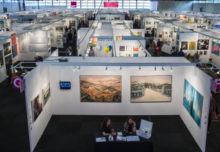In the business world feedback is seen as a massive positive force. However, in parts of the art world it can be rather different. The act of creating art usually happens in isolation which can be with an unknown destination. This is because some artists make their artwork for them selves. It can be lonely and considered as a selfish activity. They might not welcome feedback because it would interfere with the perceived integrity of their creative process. When this applies it can explain why they are not selling their work to strangers.
The term ‘feedback’ is used to describe the helpful information or criticism about prior action, service, or product from an individual, which is communicated to another individual who can use that information to adjust and improve current and future actions, services, or products. [online definition]

feedback arrows
Making art will continue to be isolated unless the artist seeks and welcomes feedback. We need to get feedback to move from hobby to serious, or from amateur to professional.
(Sit back, hunker down and await storm of indignant protest.)
It is not enough to show your work in an annual local show run by other hobbyists. It is not enough to put a couple of poor quality photos onto a free website. Instead an artist who wants to be taken seriously must show their work in as many places as is practical and even more important they must seek and value feedback in depth.
They need to know what people like or dislike about their work. It is important to try and understand how their artwork makes people feel. And I don’t mean friends or family people, I mean strangers.
Why is feedback important?
Making art is a creative act by an artist that results in a ‘work-of-art’. The very act of creativity feeds back, the artwork itself feeds back. As the artwork progresses the artist gets information, and pleasure, from the success, or lack of it, during the creative process. The finished end-result work-of-art itself provides another important type of feedback to the artist.
ARTIST ..>>>>>>.. ARTWORK ..>>>>>>.. ARTIST
This is the first step in a journey. The artist is at the start and the artwork is at the end.
A second phase in the journey happens when the same finished piece of artwork communicates with an onlooker, a different person, a stranger. This person only receives input from the artwork. For the onlooker, the artwork works, or doesn’t work, in different ways. There is no ‘act of creativity’ factor for the stranger. And crucially the artist is not involved, doesn’t influence the event, or get any feedback.
ARTWORK ..>>>>>>.. STRANGER
The third phase occurs when the stranger communicates with the artist. Did the artwork work? If not, why not? Opening up an important channel of communication between artist and stranger.
STRANGER ..>>>>>>.. ARTIST
This phase completes the loop. It starts from artist to artwork, then artwork to stranger, and finishes stranger to artist.
ARTIST ..>>>>>>.. ARTWORK ..>>>>>>.. STRANGER ..>>>>>>.. ARTIST
Feedback can now travel around the loop. Not just in one direction but in both directions. Captain, we have lift off.
ARTIST ..>>>>>>.. STRANGER ..>>>>>>.. ARTWORK ..>>>>>>.. ARTIST
How this works and why this is so important.
Ideally, a two-way dialogue opens up between the artist and the stranger. They can talk about the act of liking or not liking the artwork. They have the opportunity to discuss all aspects about the work. The artist may be able to determine why the stranger was looking at it. Which in turn will help analyse how the artwork is working.
This is a chance for the artist to appreciate that the artwork is not just for themselves, and that it can benefit strangers. Which is a huge step in an artists progress from hobby to professional. And even better, the stranger will understand why and how the artist made it. Adding other dimensions to the strangers perception and connection to the artwork, which helps sell the art.
Opportunity.
Nowadays it is very possible to get this vital feedback. Artists no longer need to be tied into a gallery system that prevents artists meeting potential collectors.
Previously galleries interest filters the collector’s reaction through a narrow, biased bottleneck. Artists do not meet the buyers. The feedback is incomplete.
Artists can now create web galleries on their own or in interesting groups. These web galleries can provide a huge variety of artwork to billions of potential collectors. Website galleries can invite and encourage direct feedback. All of these potential collectors are strangers.
And professional artists make their art for strangers. End.
*********************************************************
Also see Art Biz Secrets Part One by Colin Ruffell on Amazon
And Art Biz Secrets Part Two by Colin Ruffell on Amazon




